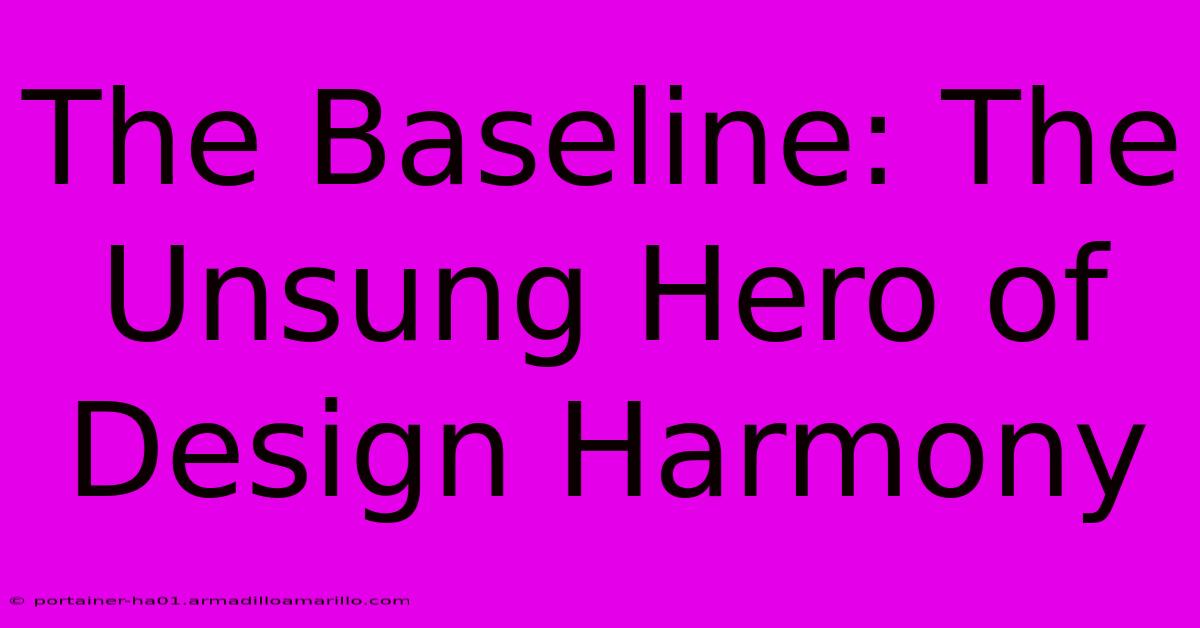The Baseline: The Unsung Hero Of Design Harmony

Table of Contents
The Baseline: The Unsung Hero of Design Harmony
The baseline. It's a term that might not immediately conjure up images of dazzling design or revolutionary aesthetics. Yet, this humble element—the invisible line upon which text rests—is the unsung hero of design harmony, quietly orchestrating visual balance and readability in countless designs. Understanding and effectively using baselines is crucial for creating professional, polished, and ultimately, more effective designs.
What is a Baseline?
In typography, the baseline is the imaginary line upon which the base of the characters sit. It's the foundational line that provides consistent vertical alignment for text. While invisible to the naked eye, the baseline's impact is undeniable. Inconsistencies in baseline alignment, even slight ones, can disrupt the visual flow of a design, creating a sense of unease and unprofessionalism. Think of it as the foundation of a house: a slightly off-kilter foundation will eventually lead to structural problems, and similarly, an inconsistent baseline will create visual dissonance.
Why is Baseline Alignment Important?
Enhanced Readability: Consistent baseline alignment significantly improves readability. When characters are consistently aligned, the eye effortlessly scans the text, reducing strain and improving comprehension. Uneven baselines, on the other hand, force the eye to work harder, leading to fatigue and reduced engagement.
Improved Visual Harmony: A well-aligned baseline contributes to a sense of order and visual harmony in the overall design. It creates a sense of stability and professionalism, making the design appear more polished and sophisticated.
Professionalism and Credibility: Attention to detail like baseline alignment speaks volumes about the designer's skill and professionalism. It conveys a sense of care and precision, boosting the credibility of the design and the brand it represents.
Mastering Baseline Alignment: Techniques and Tools
Achieving perfect baseline alignment isn't always straightforward, particularly when working with multiple fonts, sizes, or text blocks. Fortunately, several techniques and tools can assist:
1. Utilizing Design Software Features:
Most professional design software (like Adobe InDesign, Illustrator, and Photoshop) offer features specifically designed for baseline alignment. These features automate the process, ensuring consistent alignment across all text elements. Explore your software's options to discover built-in baseline grid tools and alignment functionalities.
2. Employing Grid Systems:
Implementing a robust grid system within your design provides a framework for consistent baseline alignment. The grid acts as a visual guide, ensuring all text elements adhere to the established baseline, promoting visual consistency throughout the project.
3. Careful Font Selection:
While software assists, careful font selection is paramount. Opting for fonts with consistent x-heights (the height of lowercase letters) minimizes the likelihood of baseline alignment issues. Consider font pairings that complement each other visually and share similar x-heights for optimal harmony.
4. Manual Adjustment (with caution!):
While automation is preferred, occasional manual adjustment might be necessary. Fine-tune alignment with precision, paying close attention to even the smallest discrepancies. This requires a keen eye for detail and patience, but the results are well worth the effort.
The Baseline's Impact on Overall Design
The baseline's importance transcends mere technical aspects. It contributes to a design's overall effectiveness:
-
Brand Identity: Consistent baseline alignment reinforces brand identity, conveying professionalism and attention to detail.
-
User Experience (UX): Improved readability directly impacts user experience, making content easier to consume and improving engagement.
-
Accessibility: Consistent baseline alignment is crucial for accessible design, benefiting users with visual impairments.
Conclusion: Embrace the Unsung Hero
The baseline, though often unseen, plays a pivotal role in creating visually harmonious and effective designs. By mastering baseline alignment techniques and understanding its impact on readability, visual harmony, and overall design quality, you can elevate your work to new heights, ensuring your designs are not only aesthetically pleasing but also highly functional and impactful. Don't underestimate the power of this unsung hero; embrace its importance and watch your designs flourish.

Thank you for visiting our website wich cover about The Baseline: The Unsung Hero Of Design Harmony. We hope the information provided has been useful to you. Feel free to contact us if you have any questions or need further assistance. See you next time and dont miss to bookmark.
Featured Posts
-
Unlocking Liberation The Financial Journey To Breast Reduction
Feb 07, 2025
-
Touchdown Terrors Meet The College Football Players With Names That Strike Fear And Laughter In Opponents Hearts
Feb 07, 2025
-
Sideline Side Splitters College Footballs All Star Team Of Silly Names
Feb 07, 2025
-
Heart Attack Hospital Costs In Virginia The Ultimate Guide To Financial Preparedness
Feb 07, 2025
-
The Unbelievable Truth Football Player Names That Will Make You Question Reality In 2024
Feb 07, 2025
